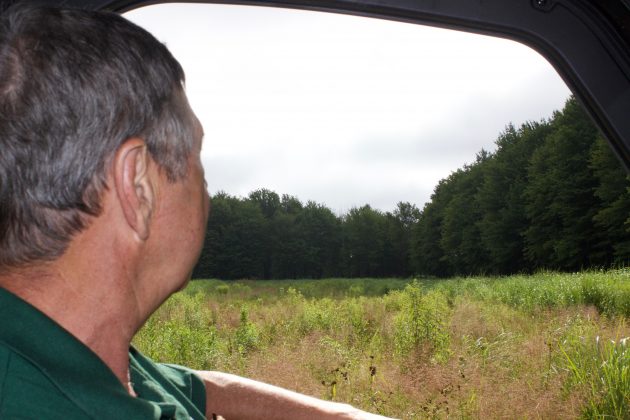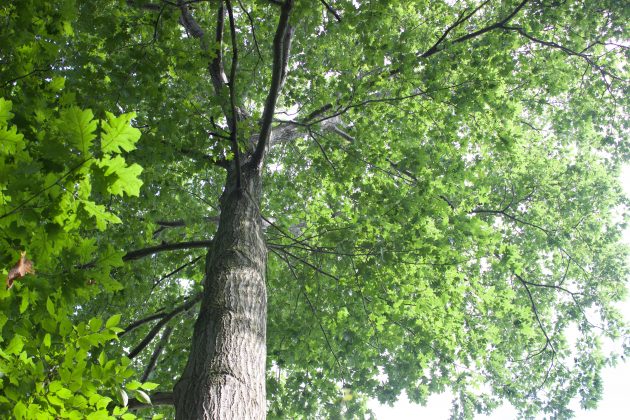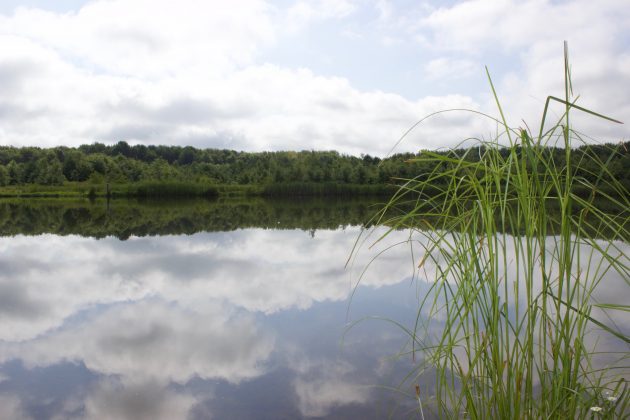
PIERPONT, Ohio — On a July morning, Paul Mechling, owner of Snowy Oak Tree Farm in Ashtabula County, sits at his kitchen table with a neatly written list of exhibitors and demonstrations planned for his 2019 Ohio Tree Farm of the Year Tour.
With the list, he holds copies of a luncheon talk he gave to the Ohio Forestry Association after being named the 2019 Ohio Tree Farm of the Year, his 2018 application for the Conservation Farm Family Awards and a flyer for the upcoming tour, which he looks at through his reading glasses.
The tour is not until Sept. 21, but Mechling had already gathered exhibitors form 10 different conservation and wildlife management organizations.
“I just wanted to really promote conservation, wildlife and forestry,” he says. “There’s a lot of farms, a lot of woodlands that do not get good management, and we’re here to try to improve that.”
Farm beginnings
Mechling and his wife, Joan, a retired teacher, bought the first 30 acres of the farm when they moved to Ashtabula County in 1974 to start a veterinary practice. Mechling was recruited out of college by the Ashtabula County planning commission and several large farmers because the county did not have enough skilled veterinarians to support the farms in the area.
“We purchased the original 30 acres before we even owned a house,” Mechling says.
Mechling, originally from Lancaster, Ohio, waited 18 years before buying more land. Finally, he had enough other veterinarians working with him that he could spend more time on conservation and forestry. Between 1997 and 2016, the Mechlings purchased 12 adjacent properties to create the 365-acre farm he owns today.
Mechling studied at Ohio State University and was accepted into veterinary school after three years of undergraduate studies.
“I never got to take any forestry or conservation classes,” he says.
Instead, he learned about forestry through reading materials from Soil and Water Conservation Districts and the Natural Resources Conservation Service and by attending seminars, field days and tree farm tours. He retired in 2012, which has allowed him to focus fully on forestry and conservation.
“That’s why I enjoy doing this. This is something a little different than veterinary medicine,” Mechling says.
Family legacy
Mechling drives a Gator down a long, gravel road from his house to the rest of the farm. He wears a green polo shirt with his farm’s name on it, jeans and boots. With the wet weather over the spring and summer, some of the trails are bound to be muddy.
He drives one-handed, letting his other elbow hang out the window. On a warm, sunny day, this is an easy trip, but the tree farm business runs year-round.
This spring, Mechling planted a plot of 2,000 red and white oak trees. While it will be 60-80 years before anyone can harvest these trees, Mechling knows his children are interested in taking over the farm eventually and hopes his grandchildren will be as well.
“It’s sort of a legacy planting,” he says.
In Perry County, his family owns Wal Mec Farm, a corn, soybean and timber farm his brother, Mark Mechling, runs.
“It goes back to my great-great-great grandfather, Jacob Mechling,” Paul Mechling says. “In 1808, he bought 1,760 acres, and we have the deed for 50 acres of that signed by Thomas Jefferson and James Madison, so legacy is big in our family.”
As a 4-H and FFA member, one of Mechling’s FFA projects involved planting trees on his family farm. His parents and grandparents were both involved in conservation projects.
“I came from a strong conservation ethic,” Mechling says. “It’s just a continuation of that, a continuation of our family background. I was raised a farm boy.”
Driving past an older plot of red oak trees, Mechling points out the red markers on the trees.
“My 10-year-old grandson marked all the oak trees … He’s pretty sharp in the woods, but he’s learned a lot helping,” Mechling says. “The big thing about family forestry is the family.”
Seasonal work
Over the years, Mechling has planted more than 140,000 conifers and hardwoods at Snowy Oak Tree Farm. The farm’s main focus is maple sap production and red oak tree growth.
The seasons dictate the work Mechling does. In the winter, he prepares for syrup season. In April, he plants trees. He planted 3,600 trees — mostly oak — last year. In the summer, he maintains roads and trails throughout the farm. Late in the summer, he manages invasive plants.
Some years, Mechling has tapped up to 3,000 trees for maple syrup, in addition to boiling 1,500 taps for neighbors, producing 1,000-1,500 gallons of syrup. He uses the money from the maple syrup to continue investing in forestry and conservation practices.
Mechling does not tap as many maple trees as he used to. Last year, he had 800 taps and produced 300 gallons of syrup. The average snowfall on the farm is 130 inches per year, so getting around in the winter often requires snowshoes.
“I’m not quite geared to do snowshoes anymore. That’s a young man’s sport,” Mechling says.
Biodiversity
While much of the farm is dedicated to forestry, Mechling believes in biodiversity.
“We do not like to see a monoculture in the woods; we like to see diverse species,” he says. “That helps protect you against diseases and insects.”
Across from stacked ash wood Mechling recently cut down for firewood, he has a plot with buckwheat, sorghum, milo and millet. He lets the plot grow for birds and other wildlife so they have more food for the winter. A ground blind for deer hunters sits at the edge of the woods next to the plot.
Adjacent to the food plot is a pollinator habitat. Around the farm, Mechling also has nesting boxes for blue birds and wood ducks.
The farm has 11 acres of protected wetlands. The ponds, home to wood ducks, mallards, Canadian geese, and sometimes bald eagles and ospreys, are filled with water lilies. Behind them sits a backdrop of pine and larch trees.
Welcome mat
The upcoming tour will not be the first time Mechling has invited people to his farm. The local high school has used the farm for envirothon training. The Mechlings have also opened the farm to Boy Scouts, for tree planting to earn forestry badges, and FFA tree planting projects.
In addition, Mechling has offered tours of the farm for local legislators, officials, leadership classes and other tree farmers.
“The tree farm promotes water, wood, recreation — we want to do all those things,” Mechling says.
The tour
The Ohio Tree Farm of the Year tour will be Sept. 21 at 9:30 a.m., at Snowy Oak Tree Farm, 6540 State Route 167. Parking will be at the Pierpont Fire Hall, 6006 Marcy Road.
For more information, contact Paul Mechling at snowyoak@windstream.net.













Great story, Miss Sarah. What a grand couple! We really do need more “Tree Farmers” in Ohio.
On our plot of 160 acres in Ashland/Richland counties we hand planted about 20,000 hardwood seedlings over the decades, and now they are MAGNIFICENT!